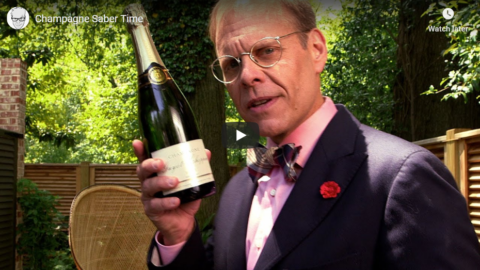Alton Brown
Published 7 May 2014A daring way to open a Champagne Bottle. Please do not try this at home.
Read the full instructions at https://altonbrown.com/sabering-champagne/
July 30, 2020
Champagne Saber Time
March 5, 2020
QotD: Champagne
I only drink champagne when I’m happy, and when I’m sad. Sometimes I drink it when I’m alone. When I have company, I consider it obligatory. I trifle with it if I am not hungry and drink it when I am. Otherwise I never touch it — unless I’m thirsty.
Lily Bollinger
April 22, 2016
Winston’s booze
Last January, Harry Wallop attempted to match Winston Churchill’s daily intake of whisky, Pol Roger champagne, brandy, and sundry other “refreshers”. He found it a challenge beyond his ready ability:
One thing is certain: his fondness for kickstarting the day with what he called “mouthwash” — a weak whisky and soda, which he would take from about 9.30 onwards and keep continually topped up. But the whisky (simple Johnnie Walker, no fancy malt) would only just cover the bottom of the tumbler; the bulk of the drink was soda.
It’s a rather delightful way to start the day, as I discover. Especially, when consumed in bed. Churchill would frequently spend all morning in his dressing gown, under the covers, surrounded by papers and secretaries. He would also happily have meetings while taking a hot bath — a habit I did not attempt to replicate.
Lunch was when the serious drinking began. A whole bottle of champagne was the norm, invariably Pol Roger, a brand Churchill drank from at least 1908. His attachment was cemented in 1944, after meeting Odette Pol-Roger (the grand dame of the champagne house) at the British ambassador’s home in Paris, where the 1928 vintage was served in celebration of the liberation of France. She ensured he was never afterwards short of supplies.
A bottle, however, was for Churchill nearly always a pint-sized one, a fairly common measure until it was phased out by champagne houses in the 1970s. He would often drink it out of a silver tankard, still served this way in some gentlemen’s clubs.
A modern politico drinking like this would already have the horrified attention of his or her M.D., but Sir Winston’s liver may have been the most superhuman part of him:
I then spent the rest of the afternoon (or what was left of it), drinking more whisky and sodas while attempting to write an article — a task I found increasingly difficult. When I returned to it the following day, I discovered it was barely literate with every other word misspelled.
After dressing for dinner (bombs raining down on London was no reason to let standards slip), Churchill would often have a sherry. A glass of Amontillado failed to sharpen my jaded appetite. Worse, I was rather dreading the second pint of champagne over dinner.
I am aware this sounds churlish, but it became progressively joyless to get through all those bubbles. By 9.30pm I was slumped in front of ‘Death in Paradise’, working out if the plot or yet another glass was going to finish me off.
[…]
Churchill, by 10pm, would have been moving onto either port or his favourite 90-year-old brandy and at least four hours of hard work.
June 6, 2014
“Fizzy dishwater” instead of Champagne for the “wine Fuhrer”
Chris Mercer on the various ways the French Champagne producers tried to keep their best wine from being diverted to the use of the Nazis:
By the time the French city of Reims was liberated in August 1944, many Champagne houses and growers had spent four years playing a game of high stakes cat-and-mouse with the local Nazi ‘wine fuhrer’, Otto Klaebisch.
As Julian Hitner writes in a feature published in the July issue of Decanter magazine, it was Klaebisch’s job to keep the Nazi empire topped up with France’s finest Champagnes. At its peak, Klaebisch was demanding 400,000 bottles per week.
In response, many Champenois resorted to subterfuge to try to protect their most precious vintages and cuvees.
As noted in the book Wine & War by Don & Petrie Kladstrup, some built fake walls in their cellar to hide their best stocks, while others intentionally mislabelled bottles.
On more than one occasion, Klaebisch suspected he was being duped. ‘How dare you send us fizzy dishwater?’ he asked 20-year-old Francois Taittinger.
‘Who cares? It’s not as if it’s going to be drunk by anyone who knows anything about Champagne,’ replied the young Taittinger, who was subsequently thrown in prison for several days.
H/T to Brendan for the link.
September 29, 2009
Calling it “bubbly” is highly appropriate
According to a recent study, the bubbles in Champagne do more than just tickle your nose:
Research shows there are up to 30 times more flavour-enhancing chemicals in the bubbles than in the rest of the drink.
Wine experts say the finding changes completely our understanding of the role of bubbles in sparkling drinks.
The study is reported in the journal Proceedings of the National Academy of Sciences (PNAS).
Commenting on the research, Dr Jamie Goode, founder of wineanorak.com, said: “In the past, we thought that the carbon dioxide in the bubbles just gave the wine an acidic bite and a little tingle on the tongue, but this study shows that it is much more than this.”




